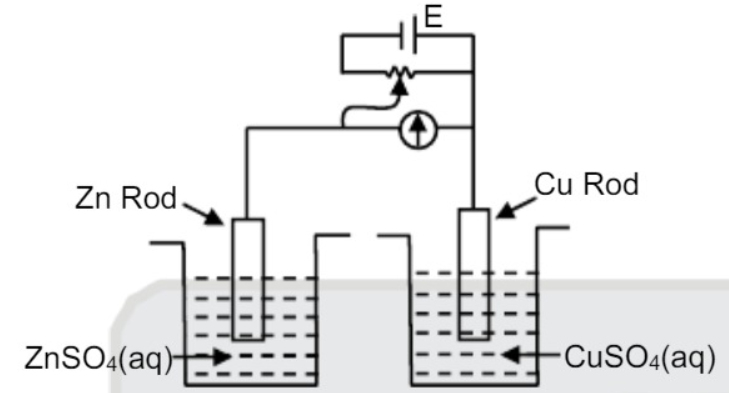If a small Cu rod is placed in an aqueous solution of ferrous salt, then which of the following will be observed? (E0Cu2+Cu=−0.34V,E0Fe2+Fe=−0.44V)
Copper will be oxidised
Fe2+ will be reduced
No reaction will take place
Fe2+will be oxidised
The correct Answer is:C
To solve the problem, we need to analyze the electrochemical behavior of copper (Cu) and iron (Fe) in the given scenario. Here's a step-by-step breakdown of the solution:
Step 1: Understand the Given Information
We are given the standard reduction potentials for the half-reactions:
- E∘Cu2+/Cu=−0.34V
- E∘Fe2+/Fe=−0.44V
Step 2: Identify the Half-Reactions
The half-reactions for the reduction of copper and iron can be written as:
1. Cu2++2e−→Cu (reduction of copper)
2. Fe2++2e−→Fe (reduction of iron)
Step 3: Compare the Reduction Potentials
The reduction potential indicates the tendency of a species to gain electrons (be reduced). A more positive (or less negative) reduction potential means a greater tendency to be reduced. Here:
- Copper has a higher reduction potential (-0.34 V) compared to iron (-0.44 V).
Step 4: Determine the Reactivity
Since copper has a higher (less negative) reduction potential, it is less reactive than iron. This means that copper cannot reduce iron ions (Fe2+) to iron (Fe).
Step 5: Conclusion on the Reaction
Since copper cannot reduce Fe2+ ions, no reaction will take place when a copper rod is placed in an aqueous solution of ferrous salt.
Final Answer
The correct observation is that no reaction will take place.
We are given the standard reduction potentials for the half-reactions:
- E∘Cu2+/Cu=−0.34V
- E∘Fe2+/Fe=−0.44V
The half-reactions for the reduction of copper and iron can be written as:
1. Cu2++2e−→Cu (reduction of copper)
2. Fe2++2e−→Fe (reduction of iron)
The reduction potential indicates the tendency of a species to gain electrons (be reduced). A more positive (or less negative) reduction potential means a greater tendency to be reduced. Here:
- Copper has a higher reduction potential (-0.34 V) compared to iron (-0.44 V).
Since copper has a higher (less negative) reduction potential, it is less reactive than iron. This means that copper cannot reduce iron ions (Fe2+) to iron (Fe).
Since copper cannot reduce Fe2+ ions, no reaction will take place when a copper rod is placed in an aqueous solution of ferrous salt.
The correct observation is that no reaction will take place.
Topper's Solved these Questions
Similar Questions
Knowledge Check
Cu+ ion is not stable in aqueous solution because because of dispropotionation reaction. E∘ value of disproportionation of Cu+ is
[E∘Cu2+/Cu+=+0.15V,E∘Cu2+/Cu=0.34V]Asecond ionisation entyhalpy of copper is less than the first ionisation enthalpyBlarge value of second ionisation enthalpy of copper is compensated by much more negative hydration energy of Cu2+(aq)Chydration energy of Cu2+(aq) is much more negative than that of Cu2+(aq)Dmany copper (I) compounds are unstable in aqueous solution and undergo disproportionation rection.Calculate ΔG∘ for the reaction : Cu2+(aq)+Fe(s)⇔Fe2+(aq)+Cu(s). Given that E∘Cu2+/Cu=0.34V,
E∘Fe+2/Fe=−0.44VA11.44 kJB180.8 kJC150.5 kJD28.5 kJ
Which is/are correct among the following? Given the half cell EMFs
E∘Cu2+/Cu=0.337V,E∘Cu+∣Cu=0.521V
View SolutionFor the given cell arrangement identify incorrect statement
given E∘_(Cu2+/Cu) = 0.34V &E∘_(Zn2+/Zn)=−0.76V
View SolutionFind the E∘cell for the following cell reaction
Fe+2+Zn→Zn+2+Fe
Given E∘Zn/Zn+2=0.76V,E∘Fe/Fe+2=+0.41V
View SolutionCu+ ion is not stable in aqueous solution because because of dispropotionation reaction. E∘ value of disproportionation of Cu+ is
[E∘Cu2+/Cu+=+0.15V,E∘Cu2+/Cu=0.34V]
View SolutionCalculate ΔG∘ for the reaction : Cu2+(aq)+Fe(s)⇔Fe2+(aq)+Cu(s). Given that E∘Cu2+/Cu=0.34V,
E∘Fe+2/Fe=−0.44V
View SolutionCan a solution of 1 M ZnSO4 be stored in a vessel made of copper ? Given that
E∘Zn+2/Zn=−0.76VandE∘Cu+2/Cu=0.34V
View Solution
